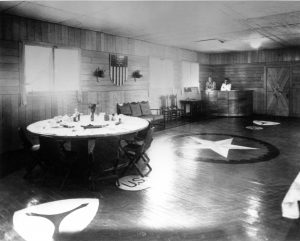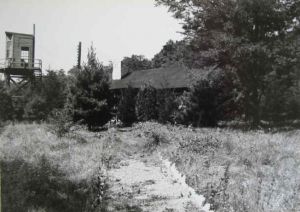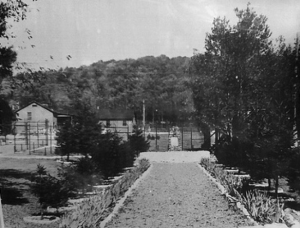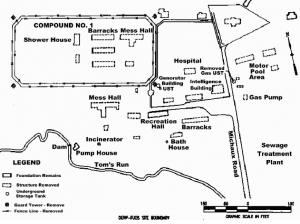On September 1st, 1939, Nazi Germany invaded Poland. Just two days later, the Allied Powers declared war, beginning the six-year conflict known as World War II. These years would be marked with catastrophic conflict. Nations passed drafts to raise world-class armies. For those citizens that remained on the “home front,” life did not get any easier. Still recovering from the global economic downturn of the Great Depression, they had to organize blood drives, ration food, and help fund their armies. They also lived (and at times worked) beside Axis Prisoners of War held on their soil. The Pine Grove Furnace Prisoner of War Interrogation Camp served as one of the U.S.’s many prisoner of war (POW) camps, but played a unique role as an interrogation camp.
The United States did not officially enter WWII on the side of the Allied Powers until December 11th, 1941, following the surprise Japanese attack on the American Naval Base at Pearl Harbor, Hawaii. It had been assisting the Allies economically for years, but it was not ready for war. However, its factories were converted to produce tanks and aircraft, and land was available for use as various Army facilities. Some of these facilities were the Prisoner of War Camps scattered across the country. They were used to house the many thousands of POWs that spent the remainder of the war in these camps. American POW Camps freed up other Allied soldiers (British, French, etc.) to fight rather than guard prisoners. A few sites including what is now known as Camp Michaux provided controlled spaces for interrogation.
During World War II, what is known today as Camp Michaux served a very important role as the Pine Grove Furnace POW Interrogation Camp. This was where potentially important Axis prisoners would be sent to be interrogated for information that could be vital to the U.S. victory in the war. According to available records, during their time at the camp, prisoners would be questioned, never tortured, and would have plenty of free time. We know that about eight prisoners had jobs around the camp such as cooks, stable hands for the horses, and were used to help maintain the camp and keep it clean. These prisoners remained at the camp for the duration of the war, while others were sent camps elsewhere in the country after their interrogation was completed. This camp was initially a Civilian Conservation Corps (CCC) camp before the war, so many of the buildings were converted to prison barracks, and one to a mess hall for the prisoners. Additional buildings were constructed during the war.

Staff Officers’ Mess Hall, courtesy of the Cumberland County Historical Society
With the exception of the old farmhouse, the camp had been built by the CCC program when the U.S. Military acquired the site. The military converted existing buildings and added additional buildings during the war. Some of the foundations of these buildings can be seen today, and historical photos show what these buildings looked like, such as the log cabin and the fountain in the photos below.

A photo showing one of the guard towers and a pathway leading to a log cabin used to house the office and quarters of the camp’s commander, Major Lawrence Thomas. Photo from the Pine Grove Furnace Park Office via the Cumberland County Historical Society.

Photo showing the entrance to the POW camp as well as the CCC fountain in the background. To the left is the gate to the main POW compound. The POW mess hall is in the rear. Copied by Chris Champion via the Cumberland County Historical Society.
Some prisoners had the skills and time to create artwork or carvings during their days at the Pine Grove Furnace prison camp. We also know the basic structure of the camp from historical photographs, maps, and some archaeological evidence of foundations and building remains. The camp was set up in a similar fashion to other prisoner of war camps across America. It had a fenced in area with guard towers that had a mess hall for the prisoners to eat in and barracks for them to sleep in. Another building outside the prison compound was used for interrogations. It can be identified as the Intelligence Building on the map below.

A map showing the 1943 layout of the Prison Grove Furnace Camp. Via Defense Environmental Restoration Program Site Map 1996 (Relabeled) and http://www.schaeffersite.com/michaux/DERmapLarge.gif

A photo showing some of the barracks where prisoners were housed. The entrance gate structure is in the foreground and the prisoners mess hall is on the right. Via the Cumberland County Historical Society.
There is, however, much we do not know about the POW period of Camp Michaux. Through archaeological evidence, we wish to answer questions such as:
- What were the lives like of the prisoners of war? We can try to piece their lives together by finding artifacts, or item such as bottles or razors that can give us an idea of what the prisoners did during their time at Pine Grove Furnace Camp. We know, through photographic evidence and inscriptions in concrete made by POWs, that some prisoners held jobs both inside and outside of the prison compound. If we find working tools that we can pair to historical evidence, we might be able to determine if the prisoners were working around the camp.
- Were the prisoners allowed outside the camp for recreation? If we found items that were representative of German or Japanese prisoners outside of the prison camp boundaries, such as a figurine or a keepsake of some kind, we might be able to determine if the prisoners were allowed outside of the camp.
- What else did they do during their free time? We might find carvings or other artwork that could tell us what the prisoners did in their free time. We can answer these questions by finding artifacts that can give us a look into the past and help us answer the questions about the lives of these prisoners. We may be able to tell what their lives were like just from everyday items.
If you’d like to do some research of your own on interrogation camps and the camp at Pine Grove Furnace, here are some sources that you could use!
Bland, John Paul.
2006 Secret War At Home: The Pine Grove Furnace Prisoner of War Interrogation Camp. Cumberland County Historical Society Heritage Publications, Carlisle. Pennsylvania.
https://www.amazon.com/Secret-Grove-Furnace-Prisoner-Interrogation/dp/0978564510
Van Cleve, Thomas C.
1942-1945 On the Activities of Two Agencies of the CPM Branch, MIS, G-2, WDGS: The Interrogation Section Fort Hunt, Virginia, Tracy, California and the MIS-X Section Fort Hunt, Virginia, Covering the Period from 1 August 1942 to 1 August 1945. United States War Department, Military Intelligence Division. http://cgsc.contentdm.oclc.org/utils/getfile/collection/p4013coll8/id/2051/filename/2040.pdf
Laird, Matthew R.
2000 “By the River Potomac”: An Historic Resource Study of Fort Hunt Park, George Washington Memorial Parkway, Mount Vernon, Virginia. National Park Service, Washington, D.C.
http://www.cr.nps.gov/history/online_books/gwmp/potomac.pdf
Metcalf, P.L.
2000 Cumberland County History. The Pine Grove Prisoner of War Camp. 17(2): 118-130.
http://gardnerlibrary.org/sites/default/files/vol17n2.pdf#page=30
Krammer, Arnold
1983 Japanese Prisoners of War in America. Pacific Historical Review 52(1): 67-91.
https://www.jstor.org/stable/3639455?seq=1#page_scan_tab_contents
Created by Calvin Bader and Justin Burkett
Many thanks to David Smith and Vince Montano for their expertise and suggestions.
Edward L Smith,Jr. says:
Attended in July, 1949 and July,1950. (From the Evangelical & Reformed Churches.) I met Eva Maria Eissmann there in July 1949. I was from Baltimore Maryland and she was from Richmond, Virginia. We were both 16 and i was born on March 24, 1933 and Eva on March 29, 1933. Eva was born in Dresden, Germany. We both are still together and will be 90 this coming March.
We were married in April 1955.
November 15, 2022 — 4:21 pm
brunom says:
How wonderful, thank you for sharing! I hope looking through the blog brought back some fond memories.
November 15, 2022 — 4:51 pm
Judy Morrise says:
What was life like there? Was Eva interned at the camp for some reason?
January 9, 2023 — 10:18 pm
Lawrence L. Martin says:
I was a camp counsllor for several summers in the 1960’s and really enjoyed the experience and leading hikes to snset ridge and other places. Wish more photos of the church camp would be posted.. Worked for a German company and exchanged jobs iwth my German counterpart ;for one year – also exchanged houses for the year. Great experience but did not encounter any of the former prisoners from Micchaux.
June 6, 2023 — 1:44 pm
Hailey Krasinsky says:
Would someone be able to reach out to me that has any information about this and I’ll explain more. I’ve been researching my grandfather and there is a chance he was here.
July 5, 2023 — 9:12 am
brunom says:
I would suggest reaching out the Cumberland County Historical Society. They have more archival information there! https://www.historicalsociety.com/
January 18, 2024 — 3:50 pm